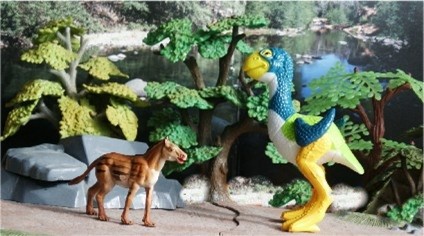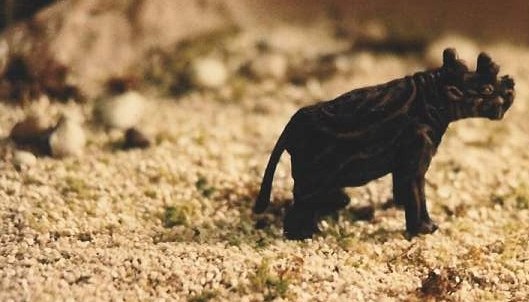From the Dinosaur Collector
The Eocene
54.8 to 33.7 mya.
update102008
Age of Mammals Diorama More Diorama
The name Eocene means the "dawn of recent life" Originally the Eocene was the first epoch of the Cenozoic, but then the Paleocene was erected as an earlier epoch. The Early Eocene is much warmer, the entire planet is experiencing a greenhouse state. The may have been an increaase in methane. Life during the Eocene was pretty similar to that of the Paleocene, a warm tropic world, high sea-levels and island continents, invertebrates and plants similar to those today, while mammals continue to evolve and diversify along many lines. The poles werewarmer with a small average temperature difference between the tropics and poles compared to the modern era. The artic supported a forested environment where now there is only frozen tundra.
| Back to Paleocene | NEXT |
Late Eocene |
In the
Late Paleocene and the Eocene there is Gastornis pariensis
(Gaston's bird"). It is based on fragmentary early finds
in Europe. A faulty reconstruction delayed recognition of the
relationship to the North American Diatryma. They
may be the same animal or at least very close relations. If so
this would indicate continued contact between North America and Europe.
From Europe is Eohippus ( Dawn Horse) or Hyracotherium
(mole beast) a palaeothere.Once thought to be an early horse
it had 4 hoofed toes on the front feet and 3 hoofed toes on each hind
foot. It had a long skull with 44 long-crowned teeth designed to browse
on leaves and shoots. The North American Hyracotherium
proably represents a range of different early horses. |
 |
| Silver Dolphin Gastornis from their WWPB (Walking with Prehistoric Beasts) activity book. Eohippus from Starlux. |
Uintatheres( Dinocerata ) were ancient, distant cousin of horses, elephants and whales. They first appeared near the end of the Paleocene and became extinct by the end of the Eocene. They left no descendents and their relationship to earlier forms are still debated. They may be related to Toxodonts and Liptoterns of South America. This was the first family of large mammals. When these larger animals die out they are suuceeded by another large bodied family. This pattern continues until the most recent extinction after the last Ice Age. When the Mega fauna everywhere but Africa dies out and is not replaced.
Starlux Uintatherium, Starlux and Bullyland have produced the widest range of prehistoric mammals of all the figure companies. Most other mammal series have become extinct rather rapidly with not nearly the same diversity.
| Uintatheres like Eobasileus were small brained much like the dinosaurs that preceded them. These animals became larger and stranger looking over time until they died out. Despite the fang it is a plant eater. While grass is presnt this was a forsted world of browsers. | Eobasileus cornuta (horned dawn king) had 6 bony knobs on its face. The rhino sized Eobasileus had saber canines and lived in the late Eocene. It was closely related to Uintatherium but a distinct animal.
|
Play Vision Eobasileus from the
large mammal series labeled as a rhinoceros to which it is only distantly
related. PlayVision based its figures on the The Simon and
Schuster Encyclopedia of Dinosaurs and Prehistoric Creatures. |
PlayVision Eobasileus from the small mammal series and Diatryma by Panini. |
Early
to middle portions of the Eocene period (45-40 million years ago).
A Uintatherium surveys his
surroundings before moving on toward the flood plain. It is a vegetarian
and usually travels alone or in small groups near water. |
Uintatherium was 10 -15 feet long and lived in North America and Asia. It was the largest plant eater of its time. |
 |
|
Riff's Lost World JA RU
Uintatherium.
Custom diorama submitted by Riff Smith photo by Bob. |
The Mesonychid Andrewsarchus from the
PlayVision small mammal series. A JA -RU Eobasileus
from China. |
There were no mammalian carnivores for the first part of the Paleocene. The mesonychids were the first mammalian meat eaters and flourished until the Oligocene when creodonts and true carnivores replaced them. Most mesonychids were the size and shape of large wolves or bears, although some were as small as foxes. Members of this group had a heavy robust skull armed with sharp canine teeth and huge round-cusped molar teeth, suitable not only for eating meat but also for crushing bone. The body was also very wolf like, with a long tail and limbs. Like many modern carnivores, mesonychids walked on the tips of their long toes, rather than flat-footed. Despite all these carnivorous adaptations, however, mesonychids were derived from hoofed mammals. The proof is in their toes, which had hooves rather than claws. By the Middle Eocene (approximately 50 to 47 million years ago), the mesonychids had declined rapidly in North America and Eurasia, where once they had dominated. The reasons for this decline are unclear. This period was a time of major climatic change, with global cooling and drying that destroyed the dense forests where mesonychids once had ruled. With the coming of open habitats, prey species became faster and more agile. Large, clumsy predators like mesonychids might have had difficulty finding cover to ambush their prey. In addition, some paleontologists speculate that mesonychids were less efficient at eating meat than creodonts or carnivores, since the blunt, rounded cusps of mesonychids molars never developed the specialized, scissor like shearing edges found in more specialized carnivorous mammals. For whatever reasons, in the late Middle Eocene the mesonychids were very rare. They disappeared from North America at the end of the Middle Eocene (approximately 37 million years ago) and from Asia in the Late Eocene (about 34 million years ago). One branch may have survived to this day in the oceans: the whales. Molecular biologists link them generally to the even-toed ungulates like Hippos, but many paleontologists favor a descent from the Mesonychia. The most primitive whales from early Eocene coastal deposits in Asia show some striking similarities to mesonychids. It seems likely that is is a case of convergent evolution.
Return to Dinosaur Collector Home